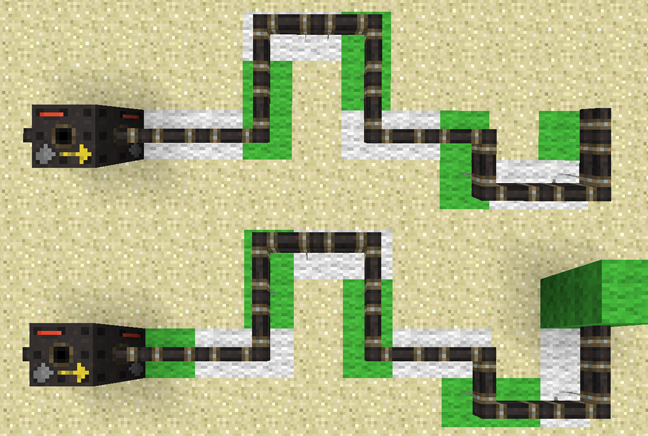
Piping is a task that is necessary if the player wishes to harvest gases. Harvesting gases can be useful for lighting your caves with Gas Lanterns, or for quickly smelting your items using a Gas Furnace, or to generate power with a Gas Dynamo.
Piping revolves around the use of blocks with a few different functions:
- Gas Pipe: Holds and transports single units of gas in a controlled fashion.
- Gas Propellor: Propels gases through pipe systems to Gas Receptors or loose ends.
- Gas Receptor: Receives gases propelled through pipe systems by Gas Receptors.
- Gas Source: Yields gas to adjacent blocks.
In piping, a full block of gas is considered a unit of gas. Gas Pipes can only hold one unit of gas, a pump can only pump one unit of gas at a time, and a Gas Bottle can contain one unit of gas. A block of air is also considered a unit of gas! This means air is treated as any other gas in piping.
Gas Filters can be applied to Gas Pumps and Gas Collectors with Including Gas Samplers and Excluding Gas Samplers. By right clicking a Gas Pump or a Gas Collector with a sampler, it will be set to filter with the setting of the sampler.
How it works
Piping is not witchcraft. It follows a few rules and always has predictable behaviour as long as you keep it under control.
- A random output (loose end or a Gas Receptor) which is reachable from the Gas Propellor, through the pipe system, is chosen. An output is reachable if the shortest path through the pipe system between them is shorter than the maximum pressure of the propellor (similar to redstone).
- If there are one or several reachable loose ends, one of these outputs will always be chosen as the output.
- The Gas Propellor will find the shortest path through the pipe system to the output. If the shortest path is matched with several paths of the same length, a random path will be chosen from this set of equally long paths.
- The units of gas in the pipes is moved along the path, towards the output.
- All Gas Pipe blocks along the path are exposed to a pressure equal to the length of the path. If a pipe is exposed to overpressure, it will make sounds and eventually break.
 How units can be pushed through pipes. The gas is represented with wool. Air must also travel through pipes like any other gas.
How units can be pushed through pipes. The gas is represented with wool. Air must also travel through pipes like any other gas.
Gas as a resource
Gas can be harvested as a resource. The player must use Gas Collectors and lead the gas through a pipe system. If collecting gases from a gas pocket, the Gas Collector should be placed either on the top or the bottom of the gas pocket depending on the density of the gas. To find gases to collect, a Gas Detector can be used. To store the gas, it can be led to a Gas Tank through the pipe system.
If the gas is fed into a Gas Transposer, it can be bottled in Gas Bottles. These bottles can be used to make Gas Lanterns, a gas-safe source of lighting. Lanterns can also be mounted on pipes. If the Lantern is fitted with an empty bottle, it can leech off gas from the pipe to produce light.
Combustible gases may be piped into Gas Furnaces for quick smelting and a few special recipes, and Gas Dynamos to produce energy for use with other Minecraft Mods.
